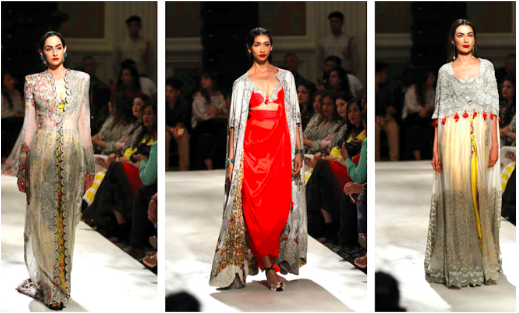Joyful Period Fashion: Eastern Wear Pakistan Styles for Every Celebration
Revealing the Rich Heritage of Eastern Style
Exploring the intricate tapestry of Eastern style reveals a world where tradition meets development, and workmanship intertwines with social importance. From the opulent silks of ancient dynasties to the elaborate needlework of nomadic tribes, each garment narrates that transcends time and boundaries, resembling the abundant heritage and artistic legacy of the East. As we peel back the layers of background and practice, a fascinating trip waits for, unwinding the tricks behind the exciting appeal and long-lasting influence of Eastern fashion on the worldwide phase.
Origin of Eastern Style

In Mesopotamia, for instance, the Sumerians and Babylonians developed garments utilizing natural leather, linen, and wool, decorated with elaborate patterns and fashion jewelry. Ancient Egyptians are renowned for their advanced weaving skills and making use of light-weight, breathable materials like bed linen. Chinese fashion emphasized the relevance of color significance and detailed embroidery strategies, while Indian apparel featured vibrant shades, glamorous textiles like silk and cotton, and fancy drapery styles such as the saree.
These ancient worlds not just influenced each other but likewise paved the method for the varied and culturally rich tapestry that is contemporary Eastern fashion. Via centuries of development, Eastern style remains to prosper, blending practice with modern-day impacts to produce classic and unique designs.
Social Influences and Customs
Attracting from centuries-old personalizeds and beliefs, cultural impacts and customs play a crucial function fit the significance of Eastern style (eastern wear pakistan). The abundant tapestry of societies throughout Eastern areas such as Asia, the Center East, and Africa has actually greatly affected the clothing styles, colors, fabrics, and designs that prevail in Eastern fashion today
In countries like India, Japan, and China, typical garments like robes, sarees, and cheongsams continue to hold significant social value and are typically decorated with detailed embroidery or symbolic patterns that reflect deep-rooted ideas and values. In Center Eastern countries, the moving abayas and kaftans put on by men and ladies not only serve as small outfit but likewise mirror the region's social heritage and Islamic traditions.
Additionally, the use of certain shades like red for great luck in Chinese society or intricate geometric patterns motivated by Islamic architecture additionally exemplify exactly how social influences materialize in Eastern style - eastern wear pakistan. By honoring and preserving these social influences and customs, Eastern style proceeds to evolve while staying real to its abundant heritage
Evolution of Eastern Wardrobe
With time, Eastern garments have gone through considerable transformations, reflecting a blend of custom and modernity in their layout and style. Conventional Eastern garments such as the saree, salwar, hanbok, and robe kameez have actually advanced to incorporate contemporary elements while preserving their cultural significance.
One remarkable advancement is using innovative fabrics and techniques in Eastern garment building. Typical handwoven fabrics like silk and cotton have actually been enhanced with modern materials such as polyester and blends, offering enhanced toughness and convenience of treatment. Furthermore, innovations in printing technologies have made it possible for elaborate patterns and designs to be included right into Eastern garments with precision and information.
In addition, modifications in silhouette and tailoring have actually improved Eastern outfit, making them much more ideal and functional for diverse events. Conventional outfit codes have kicked back, enabling experimentation with shades, styles, and decorations. This evolution has not just made Eastern garments a lot more enticing and available to a global target market but has additionally ensured their proceeded significance in contemporary style landscapes.
Significance in Eastern Clothing
Discovering the deep-rooted cultural relevance woven right into Eastern outfit reveals a rich tapestry of importance and custom. Eastern garments are typically imbued with icons that show the user's societal standing, faiths, and social identity. In many Eastern cultures, the shade red symbolizes luck and success, making it a popular option for wedding celebration outfit. Complex needlework patterns can convey stories of folklore or represent true blessings for the user.
In addition, details garments hold symbolic definitions. The robe in Japan, for example, represents tradition, regard, and rule. Its layout, fabric, and even the way it is put on all carry deep cultural significance. In a similar way, the saree in India stands for poise, sophistication, and the abundant heritage of the country. The draping style of the saree differs across regions and celebrations, each carrying its very own symbolic value.

Impact of Eastern Fashion Today

The incorporation of Eastern elements in Western style has actually resulted in a blend of styles that satisfy varied tastes and choices (eastern wear pakistan). Designers usually attract ideas from Eastern fabrics, patterns, and shapes, producing innovative and unique items that mix standard and contemporary visual appeals. This cross-cultural exchange has not only renewed the style market however also fostered a deeper admiration for Eastern heritage and workmanship
Additionally, the rise of Extra resources digital systems and social media has actually even more amplified the influence of Eastern style, allowing brand names and designers to get to a broader target market and showcase their social heritage to the globe. Through collaborations, style shows, and online campaigns, Eastern fashion proceeds to thrive and progress in today's interconnected and vibrant worldwide landscape.
Conclusion
In verdict, the rich heritage of Eastern style is a testament to the social influences, intricate workmanship, and profound symbolism installed in each garment. From ancient people to modern analyses, Eastern fashion remains to captivate with its special blend of practice and advancement. The impact of Eastern style today works as a tip of the timeless sophistication and artistic expression that have made it an international phenomenon commemorated for its abundant cultural heritage.
Discovering the intricate tapestry of Eastern fashion introduces a world where tradition meets innovation, and workmanship links with social meaning.The enduring meaning and social significance embedded in Eastern clothes proceed to form and influence the contemporary influence of Eastern style today. Eastern fashion has gone beyond boundaries, becoming a worldwide sensation welcomed by designers, stars, and style fanatics worldwide.In conclusion, the rich heritage of Eastern style is a testimony to the social impacts, detailed craftsmanship, and profound significance embedded in each garment. The effect of Eastern style today offers as Read More Here a suggestion of the classic elegance and artistic expression that have made it a worldwide phenomenon celebrated for its rich cultural heritage.